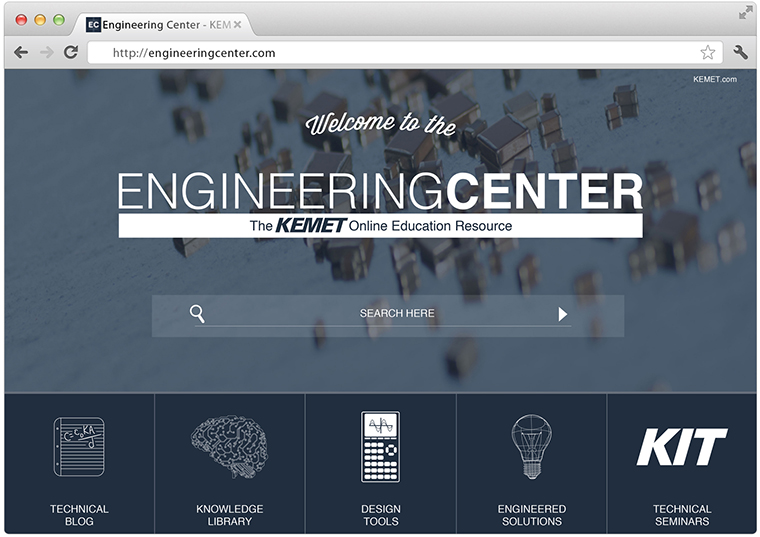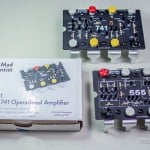Whether you are an engineer with enough experience to be called a graybeard or a novice that keeps grabbing the wrong end of a soldering iron, there is one component that eludes everyone working in electronics.
It’s the humble capacitor.
A seemingly simple device, turns out, to be incredibly complex. While the basic electrode-dielectric-electrode structure sounds simple, the materials used in that structure drastically changes the characteristics of the device.
[featured-image]KEMET Engineering Center Screenshot, Courtesy of KEMET Corporation.[/featured-image]There’s a new website created by KEMET Electronics which aims to educate all levels of engineers about the ins and outs of capacitors. They call it the KEMET Engineering Center.
In early 2011 I went to work for KEMET Electronics as a Field Application Engineer (4.5 years from this posting.) At the time of the interview, I didn’t even pronounce Tantalum correctly and kept asking “do you really need an FAE to help design in capacitors?”
Turns out, you do. Over the past years, despite reading what seemed like endless technical material, I learn something new every day. During this time, I’ve met with thousands of engineers, presented at countless conferences, and have published numerous articles on capacitors and how to use them in electronics design.
Why I’m excited about KEMET Engineering Center
I am excited and honored to be part of the team that built KEMET’s Engineering Center. Our team was a mix of electrical engineers, marketing professionals, content editors, graphic designers, and UX/UI engineers. Engineering Center is truly a website designed and built by engineers for engineers. The content isn’t just marketing fluff. It ranges from high-level to deep-dive.
Here’s an overview of the types of content you’ll find in Engineering Center and why I suggest adding KEMET Engineering Center blog’s RSS feed to Feedly or your RSS reader of choice.
1. Application Blog
KEMET’s team of Field Application Engineers is truly a global engineering team. They meet with hundreds of customers every week, helping solve problems. The problems can range from “how to pick a decoupling capacitor” to “help me design a UPS bank.”
The Application Blog provides a place for the FAEs and KEMET’s other technical engineers to provide answers to common questions. Right now there are posts ranging from the differences between BME and PME Ceramics, to why ceramics lose capacitance, and an introduction from the CTO
2. Knowledge Library
In their previous archive, KEMET had about 100 technical application notes, articles, and white papers. These have been updated, and will be continued to be updated, into new resources focused directly on electrical engineers in the Knowledge Library.
If you’re a “get down to the details” kind of person, you’ll enjoy looking for the white papers KEMET offers. Their scientist get down to the atomic level of how the different materials used in capacitors affect their performance and characteristics.
New engineers will want to look for the App Briefs and eBooks that give a higher-level explanation.
Careful, though, it is easy to spend an entire day reading some of the stuff found in Engineering Center’s Knowledge Library.
3. Design Tools
Quick, how much does dc voltage affect a ceramic capacitor? Trick question, the only right answer is: it depends (my famous answer at any seminar.) It depends on the dielectric material, the dielectric coefficient, the amount of voltage applied, the rated voltage, and in some cases, the size of the capacitor itself. Confused yet?
That’s why KEMET WebSPICE is an awesome tool. It is a web-based simulator that gives you an idea of what a capacitor’s parameters will be with an application voltage, temperature, and frequency applied to it.
Aluminum Electrolytic Capacitors have a known limited lifetime—how long until the electrolyte is consumed. While data sheets and catalogs will often provide charts and estimations, they are usually difficult to relate to a specific application. That’s why a featured link is the “KEMET Aluminum Electrolytic Life Calculator.” This tool will take a specific capacitor and calculate estimated lifetime based on your application’s temperature, available cooling, and a spectrum of the ripple current.
Over time, more tools are expected to be added.
4. Engineered Solutions
Remember the story from my interview, where I kept asking: “what do capacitor FAEs do?” Well, turns out, one task is designing custom solutions for customer applications.
There are two areas I spent a lot of time doing custom work: designing capacitor banks for SSDs and custom brick capacitors for DC-Link applications.
5. Technical Seminars
As I mentioned, I’ve met with thousands of engineers. One of the reasons I’ve met so many is that I regularly present at KEMET’s “Institute of Technology”, or KIT, seminars. These seminars range from 2 hours to 2 days in length.
My favorite aspect of KIT is that the team concentrates on providing technical presentations and not fluffy product pitches.
The goal is to make sure everyone walks away with learning something new. In fact, this year the team is planning something like 100 of these events.
Conclusion
If you can’t tell, I’m pretty excited about this project. So many engineers or enginerds want to know more about components. Here’s a resource focused on providing the technical aspects and not just force you into a catalog. Browse through the information available on KEMET’s Engineering Center.




